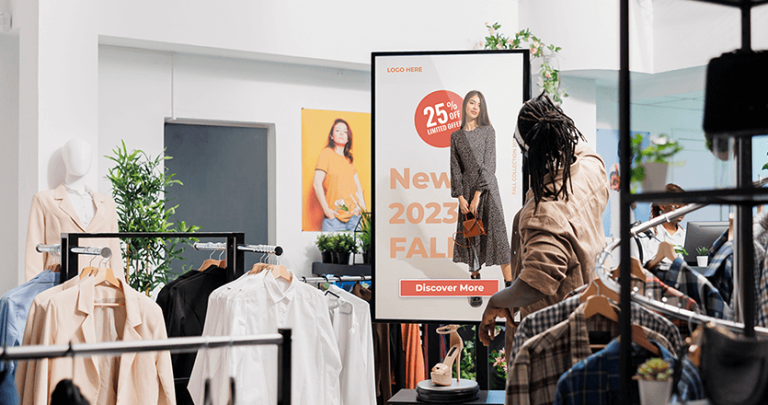Table of Contents
The Impact of Digital Signage on Retail Business
The retail industry is evolving rapidly, with technology playing an increasingly significant role in the way brands engage with customers. One of the transformative technologies in this space is digital signage, an innovative tool that’s becoming essential for retailers aiming to enhance customer experience and improve sales metrics. Integrating Just Digital Signage into a retail environment can create a dynamic and interactive shopping experience, capturing the attention of shoppers and conveying information more effectively than traditional signage can.
The Benefits of Digital Signage Solutions
There are multiple benefits to using digital signage in a retail setting. One of the primary advantages is the ability to update content quickly and easily. Unlike static posters or banners, digital signs can be updated in real-time to showcase the latest promotions, products, or information. This makes it an invaluable tool for retailers who need to respond quickly to market trends or inventory changes. Furthermore, digital signage can encompass an array of formats, from basic displays to interactive kiosks, thus providing versatility for retail marketing strategies.
Driving Retail Sales Through Effective Display Strategies
Attracting customer attention is the first step towards increasing sales. By utilising striking visuals and moving images, digital signs can capture and maintain consumer interest much more effectively than static images ever could. Moreover, integrating elements such as touchscreens invites direct interaction, further engaging customers and potentially influencing purchase decisions.
Another strategic use of digital signage is in the promotion of offers and discounts. Flash sales, special deals, or loyalty rewards highlighted on screens can entice customers to make impulsive purchases they might not have considered otherwise. Retailers are finding that strategically placed digital signage at points of decision – such as end caps or the point of sale – can significantly impact purchasing behaviour.
Cultivating an Impressive Brand Image
Customer perception of a retail brand can be greatly enhanced by the modern and sophisticated image that a digital display conveys. A store employing advanced technological solutions, such as those provided by Just Digital Signage, is often considered forward-thinking and customer-focused, adding to the brand’s cachet. Hence, digital signage not only drives immediate sales but can also contribute to long-term brand loyalty and retention.
Customisation and Personalisation
One of the innovative aspects of digital signage is its capacity for personalisation. Screens can display custom content based on the time of day, weather, or even specific customer interactions. Personalisation is a key factor in modern retailing; it makes customers feel valued and can directly influence shopping behaviour, making personalisation through digital signage a powerful sales tool.
The Role of Digital Signage Software and Media Players
To fully exploit the potential of digital signs, the role of robust retail labels software and media players cannot be overstated. They are pivotal in managing content across a network of screens, ensuring seamless updates and scheduling of signage content. This technology empowers retailers to create and curate engaging multimedia content, tailor their messaging, and deliver it in high definition to capture the imagination of their audience.
Enhancing In-Store Experience with Interactivity
Digital signage also enriches the in-store experience by offering functionalities beyond mere advertising. Interactive kiosks can allow customers to check product availability, read reviews, or even order items directly from the screen. Such features not only enhance the customer’s shopping experience but also free up staff to attend to other service tasks, thus improving overall store efficiency.
Regional Variations in Digital Signage Adoption
The implementation of digital signage solutions can vary considerably from region to region. For instance, retailers looking for digital signage gold coast providers may encounter different trends and customer expectations than those in other Australian cities or global markets. It’s important for retailers to understand their local market dynamics to tailor their digital signage approach accordingly.
Measuring the Success of Digital Signage
Beyond anecdotal evidence, retailers are increasingly deploying analytical tools to gauge the effectiveness of digital signage. Metrics such as increased foot traffic, higher conversion rates, and uplifts in average purchase value provide tangible evidence of the ROI that digital signage can deliver. With such data, retailers can continually refine their digital marketing strategies, ensuring they resonate with their target audiences and drive sales.
Conclusion
As the retail landscape continues to shift towards more integrated and interactive experiences, the importance of digital signage as a sales tool cannot be understated. When implemented correctly, digital signage solutions such as those offered by Just Digital Signage can significantly boost retail sales by enhancing customer engagement, personalising the shopping experience, and creating a modern brand image. By investing in quality digital signage solutions—including advanced retail labels software and media players—retailers can ensure that they remain competitive in an increasingly digital market. Whether leveraging the expertise of digital signage gold coast specialists or elsewhere, the potential for increased sales and improved customer loyalty through digital signage is immense, making it a key strategy for retail success in the digital age.
Author’s Note:
The impact of digital signage on the retail sector is not just a speculation but a proven advantage, evidenced by the growth and innovation seen in those retail businesses embracing this technology. Adoption of such digital solutions paves the way for an immersive, efficient, and profitable retail environment, setting the tone for the future of consumer retail experiences.
